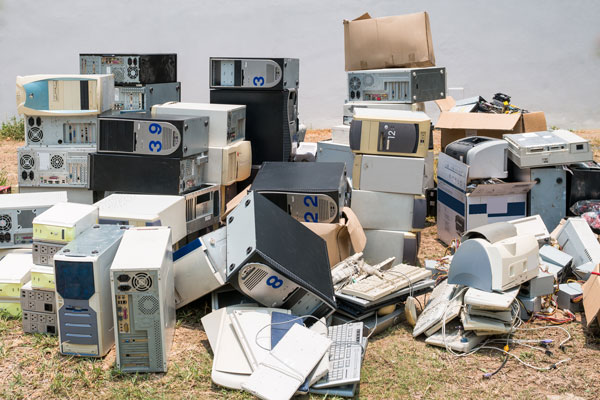Top 3 Reasons E-Waste is your Next Big Problem

Whether a company regularly upgrades IT equipment to keep pace with cutting edge technologies, is migrating to the cloud, or simply finds itself with end-of-life hardware it no longer needs, all face the same dilemma: what to do with the no longer needed legacy equipment. Companies faced with this predicament soon realize the problem of excess technology is much more complex than what they face when simply updating their office furniture. Here are three reasons why e-waste may be your next big problem:
1) Improperly Recycled e-Waste Can Negatively Impact the Environment
Global e-waste generation reached approximately 44.7 million metric tons, or 6.1 kg per person in 2016, according to The Global e-Waste Monitor 2017 report, and is still growing by more than 3 percent per year. This figure is only going to increase as businesses, particularly those undergoing cloud migration rendering a large amount of their hardware unnecessary, create e-waste at an accelerated pace. Improperly disposed of IT assets not only add large quantities of waste to already overfilled landfills, but this improper disposal allows toxic materials to leak into the environment, with potentially harmful effects on both wildlife and humans.
There is an eco-friendly alternative, however. Rather than dumping fully functional, pre-used equipment, companies may consider reselling them through an established market vendor that specializes in brokering the sales for legacy IT assets. This option is not only good for the environment but also preempts the next of a company’s big problems when it comes to e-waste: data privacy and compliance.
2) Data Privacy and Other Compliance and Regulatory Issues
Proper disposal of aging equipment is essential for compliance not only for environment regulations but for data security rules and restrictions. Ensuring your business properly protects the data and information stored on outdated hardware is just as important as preventing data breaches from systems currently in use. If a business does not know how to effectively wipe its gear it is exposing itself to a litany of issues including legal exposure to lawsuits and other potentially damaging financial penalties and fines. Simple wiping of assets is most often neither sufficient nor secure enough. Companies should strongly consider an IT disposal plan that includes hard drive shredding, degaussing, and crushing as a solution.
Proper data destruction is paramount for any company that values privacy and security. To guarantee your company’s data destruction is done properly, you should consider working with an ITAD organization that follows NIST standards, abides by the EPA’s recommendations for proper recycling, and is R2 and e-Steward certified. This ensures that the equipment is being properly disposed of based on both best practices and industry compliance requirements.
A specialized partner can ensure that hardware disposal meets the various compliance requirements set forth by NAID® certification. An unbroken chain of administration, including witnessed and verifiable proof of hard drive destruction is necessary and can be performed on-site.
3) Outdated Assets Represent a Lost Investment
The most effective way a company can recoup some of the expense earmarked for technology refreshment is to utilize IT asset recovery services from a reputable provider. Selling equipment to a third party is a great way to recoup costs for legacy equipment. There are a variety of factors to consider to ensure a substantial return, however. Makes, models, types, and age of equipment, as well as the equipment’s condition, for example, should be taken into consideration when formulating an IT upgrade budget plan. To ensure your company gets the most return on investment, it is recommended you follow five easy steps when preparing for IT asset removal and recovery:
- Keep the Equipment in Good Shape
- Keep the Systems Complete
- Utilize Professional Data Sanitization
- Create a Detailed List of Your IT Assets
- Partner with a Reputable IT Asset Recovery Company
Disposing of e-waste, when done properly, can save thousands of tons of unnecessary waste being deposited into landfills, mitigates the risk of security and privacy breaches, and can successfully recuperate costs that can aid in reimbursing often pricey upgrade costs. Organizations that dispose of their e-waste carelessly, however, not only may harm the environment, but also risk incurring fines and reputational damage from data breaches or environmental compliance failures
In addition to its IT asset management and compliance services, Liquid Technology is an industry-leading company focused on data erasure and providing best-in-class services to help mid- to large-sized companies save money, streamline operations, and improve overall data security. A key element of their business is providing comprehensive and auditable data destruction services that adhere to the latest NIST guidelines for secure data destruction, while meeting the EPA’s recommendations for the proper recycling and disposal of e-waste. Having gained experience from working with numerous companies across different industries, Liquid Technology provides the assurance, know-how, and cost-savings required for companies to turn a potential compliance disaster into revenue, improving corporate responsibility and sustainability in the process.


